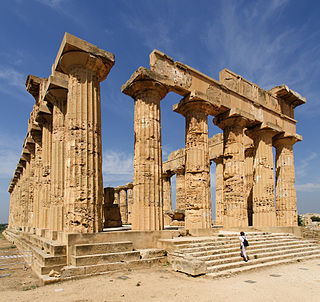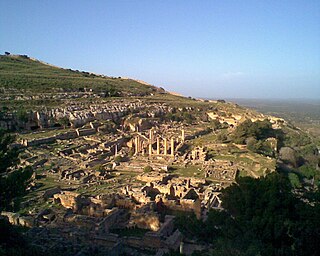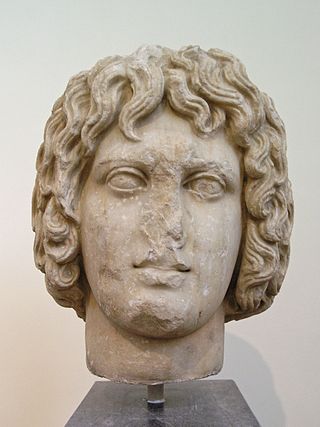Related Research Articles

In ancient Greek religion and mythology, Demeter is the Olympian goddess of the harvest and agriculture, presiding over crops, grains, food, and the fertility of the earth. Although she is mostly known as a grain goddess, she also appeared as a goddess of health, birth, and marriage, and had connections to the Underworld. She is also called Deo (Δηώ). In Greek tradition, Demeter is the second child of the Titans Rhea and Cronus, and sister to Hestia, Hera, Hades, Poseidon, and Zeus. Like her other siblings but Zeus, she was swallowed by her father as an infant and rescued by Zeus.

In ancient Greek mythology and religion, Persephone, also called Kore or Cora, is the daughter of Zeus and Demeter. She became the queen of the underworld after her abduction by and marriage to her uncle Hades, the king of the underworld.

Selinunte was a rich and extensive ancient Greek city on the south-western coast of Sicily in Italy. It was situated between the valleys of the Cottone and Modione rivers. It now lies in the comune of Castelvetrano, between the frazioni of Triscina di Selinunte in the west and Marinella di Selinunte in the east.
Locri is a town and comune (municipality) in the province of Reggio Calabria, Calabria, southern Italy. Its name derives from that of the ancient Greek region of Locris. Today it is an important administrative and cultural centre on the Ionian Coast and within its province.

The Eleusinian Mysteries were initiations held every year for the cult of Demeter and Persephone based at the Panhellenic Sanctuary of Eleusis in ancient Greece. They are considered the "most famous of the secret religious rites of ancient Greece". Their basis was an old agrarian cult, and there is some evidence that they were derived from the religious practices of the Mycenean period. The Mysteries represented the myth of the abduction of Persephone from her mother Demeter by the king of the underworld Hades, in a cycle with three phases: the descent (loss), the search, and the ascent, with the main theme being the ascent of Persephone and the reunion with her mother. It was a major festival during the Hellenic era, and later spread to Rome. Similar religious rites appear in the agricultural societies of the Near East and in Minoan Crete.
Eleusinion was a sanctuary in Athens, Greece, dedicated to Demeter and Kore (Persephone).

Elefsina or Eleusis is a suburban city and municipality in the West Attica regional unit of Greece. It is located in the Thriasio Plain, at the northernmost end of the Saronic Gulf. North of Elefsina are Mandra and Magoula, while Aspropyrgos is to the northeast.

Cyrene or Kyrene, was an ancient Greek and later Roman city near present-day Shahhat, Libya. It was the oldest and most important of the five Greek cities, known as the pentapolis, in the region. It gave eastern Libya the classical name Cyrenaica that it has retained to modern times. Located nearby is the ancient Necropolis of Cyrene. The traditional founder of the city was Battus the Lacedemonian, though the exact relationship between the fledgling city and other cities has led historians to question that narrative. Particularly, the idea that Thera was the sole "mother city" is disputed; and the relationship with other cities, such as Sparta and Samian merchants, is unclear.

Dion is a village and municipal unit in the municipality of Dion-Olympos in the Pieria regional unit, Greece. It is located at the foot of Mount Olympus at a distance of 17 km from the capital city of Katerini.
The year 1969 in archaeology involved some significant events.

In Greek mythology, Despoina or Despoena was the daughter of Demeter and Poseidon and sister of Arion.
Aretaphila of Cyrene was a Cyrenean noblewoman. According to Plutarch in his work De mulierum virtutes, she deposed the tyrant Nicocrates.

In classical architecture, hypaethral describes an ancient temple with no roof. It was described by the Roman architect Vitruvius in his treatise De architectura, written for the emperor Caesar Augustus probably about 15 BC.
The Extramural Sanctuary of Demeter and Persephone at Cyrene, Libya is located on a coastal plateau of Libya, beyond the boundaries of the city (extramural). In approximately 630 BC Greeks from the island of Thera colonized Cyrene. Other Greek colonists not long after increased the population, thus transforming Cyrene into what was regarded as both the largest and wealthiest Greek colony of North Africa. Archaeological excavations of Cyrene's Extramural Sanctuary of Demeter and Persephone, also known as Kore, daughter of Demeter and legendary Queen of the Underworld and consort of Hades, began in 1969 under the sponsorship of the University of Michigan. Between 1973 and 1981 the University of Pennsylvania Museum of Archeology and Anthropology continued the excavations at Cyrene under the direction of Professor Donald White. Following the renewal of relations between Libya and the United States in 2004, the Cyrenaica Archaeological Project (CAP), under the direction of Professor Susan Kane of Oberlin College, was granted permission to resume the work of its predecessors.

In ancient Greek religion and myth, Eubuleus is a god known primarily from devotional inscriptions for mystery religions. The name appears several times in the corpus of the so-called Orphic gold tablets spelled variously, with forms including Euboulos, Eubouleos and Eubolos. It may be an epithet of the central Orphic god, Dionysus or Zagreus, or of Zeus in an unusual association with the Eleusinian Mysteries. Scholars of the late 20th and early 21st centuries have begun to consider Eubuleus independently as "a major god" of the mysteries, based on his prominence in the inscriptional evidence. His depiction in art as a torchbearer suggests that his role was to lead the way back from the Underworld.

The Castle of Mytilene, also Fortress of Mytilene, is located in Mytilene on the Greek island of Lesbos, North Aegean. It is maintained in good condition and is one of the largest castles in the Mediterranean covering an area of 60 acres. The first castle on the site may have been erected during the time of Justinian I. The 6th-century castle may have been built on top of an already existent fortress. In the late Middle ages, the castle was the residence of Francesco I Gattilusio and his successors, especially the tower known today as the Queen's Tower. There is also strong evidence that the original acropolis on the site may have included a sanctuary to Demeter, Kore and Cybele.
The religious element is difficult to identify in Mycenaean Greece, especially as regards archaeological sites, where it remains very problematic to pick out a place of worship with certainty. John Chadwick points out that at least six centuries lie between the earliest presence of Proto-Greek speakers in Hellas and the earliest inscriptions in the Mycenaean script known as Linear B, during which concepts and practices will have fused with indigenous Pre-Greek beliefs, and—if cultural influences in material culture reflect influences in religious beliefs—with Minoan religion. As for these texts, the few lists of offerings that give names of gods as recipients of goods reveal nothing about religious practices, and there is no other surviving literature.
P. Gregory Warden is an American archaeologist, President and Professor of archaeology at Franklin University Switzerland, and expert on Etruscan art, archaeology, and ritual, Roman architecture and Greek archaeology.
The Temple of Demeter Amphictyonis was an extra-urban sanctuary in ancient Anthele in Thermopylae, dedicated to Demeter. It was an important Panhellenic shrine of Demeter and one of her main cult centers in Greece. It was also known as a center of the Amphictyonic League.
The Sanctuary of Demeter and Kore was a sanctuary in ancient Syracuse in Sicily, dedicated to Demeter and Kore (Persephone).
References
- ↑ Susan-Marie Cronkite , The Sanctuary of Demeter at Mytilene: A Diachronic and Contextual Study. Volume Two Catalogue , 1997, Institute of Archaeology, University College London